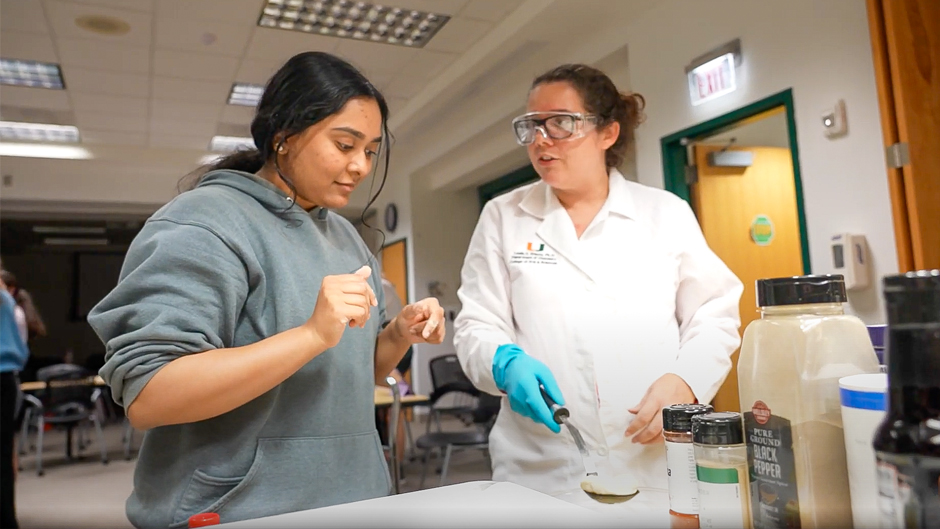Cayenne pepper and chocolate. Smoked salmon and ice cream.
These are just some of the food pairings students in Leslie Knecht’s The Chemistry of Food and Taste course considered as they explored combinations of food based on molecular similarities. In this hands-on course, Knecht and her students delve into the chemical process of cooking, while enabling them to put their knowledge into practice.
During each fall semester at the University of Miami, Knecht takes her class on a journey discovering how chemical interactions work together to drastically change raw ingredients into a delicious—or maybe not so great—dish. Before each cooking session at the Patti and Allan Herbert Wellness Center Kitchen, Knecht introduces a new chemical process and explains how even the smallest recipe alteration could significantly impact the final dish.
“This is one of my favorite courses to teach at the University of Miami,” said Knecht, a senior lecturer in the Department of Chemistry at the College of Arts and Sciences. “Students really get to see how a chemical process works, and it also helps them to connect chemistry to their everyday lives.”
First introduced in 2015 by Barbara Colonna, a former senior lecturer, The Chemistry of Food and Taste has become a high-demand elective among chemistry majors at the University. Every fall semester, the class opens its doors to 20 students. The class combines knowledge from both 200-level organic chemistry and organic reactions and synthesis courses, providing a comprehensive overview of the subject.
Alyssa Rice said the course combines two of her passions.
“Growing up, I would watch my mom bake cakes for many people and it exposed me to the science of baking early on,” said Rice, a senior double majoring in chemistry and marine science. “This combines both my interests, and it has easily been one of my favorite chemistry classes.”
Recently, the class focused on making pretzels from start to finish to help them visualize the Maillard reaction—simultaneous chemical reactions that happen when sugars and proteins are transformed by heat to create melanoidins, edible pigment molecules.
Rice’s most memorable moment in the course was when she made cayenne pepper chocolate chip cookies.
“Right before Thanksgiving, we got to break into groups and we were tasked with combining two flavor molecules that wouldn’t typically go together but may produce something that actually tasted well together,” said Rice. “It was cool brainstorming our idea and conceptualizing it together. We got to taste everyone’s finished products at the end—it was a fun project that I’ll never forget.”
Teaching assistant Kyle Meerbott said that it has been a pleasure working with the students this semester.
“It’s a lot of fun being in the kitchen,” said Meerbott, a graduate student in the chemistry program. “We do this stuff at home anyway, so combining my passions for teaching and cooking with the students has been amazing.”
The final exam is a culmination of at least two of the skills, as well as the knowledge, the students gained throughout the course. And it involves cooking a dish that was not previously made in the class. Knecht challenges them to put their own unique recipes to the test, be creative, and have fun.
“This final exam is an opportunity for students to showcase their skills and challenges them to think critically, work together, and apply their knowledge in an exciting way,” said Knecht. “By the end of the course, I hope my students feel proud of themselves and have gained a deeper understanding of chemistry and the art of cooking.”

